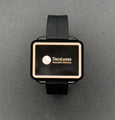
-
Description
-
Review
-
Shipping
-
Return
Red Light Therapy Band: The Next Wave in Anti-Aging
The Red Light Therapy Band is an innovation in red light therapy, using the wrist as the primary focal point of red light. This allows for the circulation of blood (every 30 minutes) to cross under the red light exposure for all the benefits of red light therapy.
The Red Light Therapy Band has been clinically tested and proven to increase ATP energy production, reduce inflammation, oxygenate the blood, aid in the production of cells, and improve balance. In addition, it reduces oxidative stress which leads to a reduction in wrinkles and age spots.
The patented RED LIGHT PULSE technology delivers 200 Jules through your skin while creating a pulsating effect that stimulates collagen production and increases circulation by creating micro-tears that heal faster than normal skin. With this patented technology, you can expect results in as little as two weeks!
This band is also rechargeable which means no need for batteries or cords! Simply plug it into any USB port or wall charger for continuous use anywhere in your home or office for three months at a time without needing another charge! It comes with 10 different colors so you can mix and match colors or wear one color at a time!
For orders placed before 7 am EDT, we endeavor to process the same business day. Orders placed after 11 am EDT will be processed the next business day.
During sale events and new collection launches, a slightly longer processing time may occur.
All orders are hand-picked and packed with love from Palm Bay, Florida.
You can choose between a refund or a credit note on full priced items.
- Item(s) must be returned in their original condition and packaging: unworn, unwashed and with all tags attached.
- Earrings cannot be returned due to health and safety reasons.
- Return shipping methods and associated costs are the responsibility of the customer.
- Sale items can not be refunded for change of mind.
Recently Viewed Products
TECH SPECIFICATIONS
- Rechargable Lithium Battery
- Adjustable metal band
- Wall charging unit (USB cord included)
- Red light spectrum: 625nm & 660nm
- 200 jules
- US Patent Pending#5606883
- International Patent Pending
- Hard plastic casing
- 5 Led power level notification
- 3 / 30 min cycles per 1 charge
- 3 month warranty
- 2 year lifetime use
- US Assembly
What is Red Light Therapy?
Red Light Therapy (RLT) has been studied since the early 1990s by many scientists, including NASA, due to its inherent properties of promoting growth and photosynthesis. Subsequently, it is currently being studied for its potential applications in medicine. NASA's interest was relative to the ability of Light Therapy to treat muscle atrophy and bone density, both issues of weightlessness, during space travel.
RLT was then studied more extensively in the medical arena for its ability to effectively increase cellular metabolism, establishing it as an effective treatment for skin issues such as wrinkles, scars, persistent and non-healing wounds, and other conditions. There are several types of red-light therapies like in red-light beds found at salons which have been shown to help reduce cosmetic skin issues such as wrinkles and stretch marks. Red light produces a biochemical effect in cells that strengthen the mitochondria. The mitochondria are the cell's powerhouse, where the cells' energy is created.
The energy-carrying molecule found in the cells of all living things is ATP (adenosinetriphosphate). When RLT is combined with Liposomal Methylene Blue (LMB), the LMB is photoactivated, subsequently increasing the function of the mitochondria exponentially and enhancing the production of ATP. With this great energy, cells can function more efficiently, and rejuvenate themselves, (as in repairing damaged cells and removing the non-functioning cells), hence decreasing inflammation and swelling.
| HEALTH | BEAUTY | FITNESS |
| | | |
| | | |
BENEFITS | BENEFITS | BENEFITS |
|
|
|














